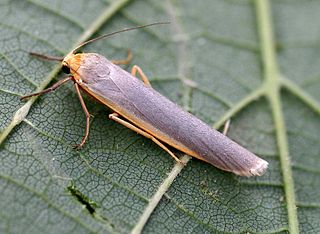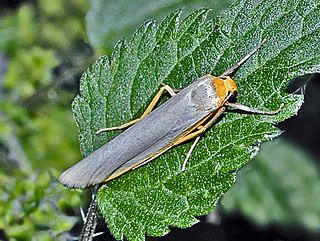Capissa is a monotypic tiger moth genus in the family Erebidae. It was previously treated as a synonym of Eilema. Its only species, Capissa vagesa, is found in the north-western Himalayas, Kashmir, Nepal and Upper Myanmar. Both the genus and species were first described by Frederic Moore; the genus in 1878 and the species in 1860.
Collita is a genus of moths in the family Erebidae. The genus was described by Moore in 1878.

Eilema is a genus of moths in the subfamily Arctiinae. The genus was erected by Jacob Hübner in 1819.

Manulea complana, the scarce footman, is a moth of the family Erebidae. The species was first described by Carl Linnaeus in his 1758 10th edition of Systema Naturae. It is found throughout the Palearctic region.

Katha depressa, the buff footman, is a moth of the family Erebidae. It is found from western Europe east through the Palearctic to Korea and Japan.

Wittia sororcula, the orange footman, is a moth of the family Erebidae. The species was first described by Johann Siegfried Hufnagel in 1766. It is found in Europe, Anatolia and further east across the Palearctic to southern Siberia and the Amur basin to China.

Eilema caniola, the hoary footman, is a moth of the family Erebidae. The species was first described by Jacob Hübner in 1808.

Manulea replana, the lichen-eating caterpillar or lichen moth, is a species of moth of the subfamily Arctiinae. It is found in Australia.
Dolgoma angulifera is a moth of the family Erebidae first described by Felder in 1868. It is found in India, Sri Lanka and Thailand.
Dolgoma oblitterans is a moth of the family Erebidae first described by Rudolf Felder in 1868. It is found from the Himalayas, Sri Lanka to Yunnan. There is also a record from Tanzania.
Collita vetusta is a moth of the family Erebidae. It is found in Japan, the Russian Far East, northern China and Korea.
Collita coreana is a moth of the family Erebidae. It is found in Korea. Records for the Russian Far East and Japan are probably based on misidentifications of Manulea ussurica.
Collita gina is a moth of the family Erebidae. It is found in Japan.
Collita digna is a moth of the family Erebidae. It is found in the Russian Far East.
Collita chinensis is a moth of the family Erebidae. It is found in Mongolia and China.
Manulea pseudofumidisca is a moth of the family Erebidae. It is found in Russia, North Korea and China.
Manulea fuscodorsalis is a moth of the family Erebidae. It is found in Taiwan and Japan.

Manulea bicolor, the bicolored moth or yellow-edged footman, is a moth of the family Erebidae. It is found in boreal North America, from Labrador and Massachusetts to Yukon and British Columbia. In the Rocky Mountains, it ranges south to southern Colorado. The habitat consists of boreal forests, parklands and riparian cottonwoods in the prairies.
Prabhasa plumbeomicans is a moth of the family Erebidae. It is found in the north-eastern Himalayas and in Myanmar, as well as on Borneo.
Tarika is a monotypic moth genus of the subfamily Arctiinae in the family Erebidae. Its only species, Tarika varana, is found in Sikkim, India. The genus and species were both first described by Frederic Moore; the genus in 1878 and the species in 1866.






